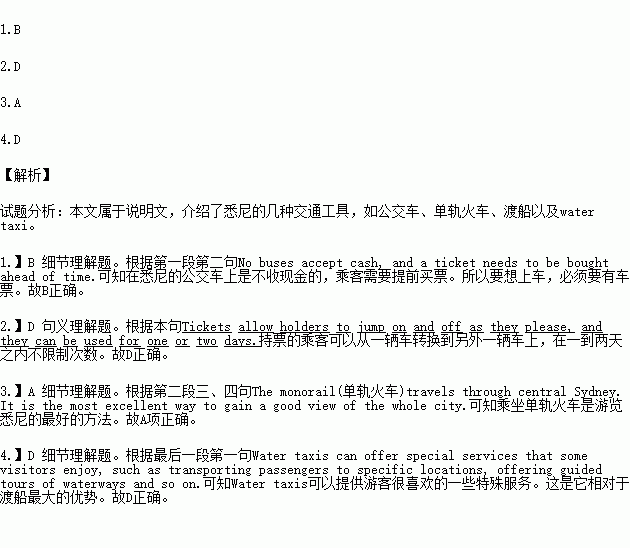题目内容
Sydney has a huge bus system. No buses accept cash, and a ticket needs to be bought ahead of time. The buses often run at busy hours and regularly during the day. The Sydney Explorer bus provides air-conditioned service and stops at 27 tourist attractions. Its partner, the Bondi Explorer, stops at 19 attractions. Tickets allow holders to jump on and off as they please, and they can be used for one or two days. It's an easy way to see the city and the surroundings.
Sydney's train service runs throughout the central city area and the surroundings. Tickets can be bought from machines that operate 24 hours a day or from ticket offices. The monorail(单轨火车)travels through central Sydney. It is the most excellent way to gain a good view of the whole city. The monorail runs every three to five minutes, and it takes 15 minutes to complete its journey.
Sydney is built around a harbor, and the Parramatta River has a large ferry(渡船)system. It serves the area around the harbor. These include Taronga Zoo, Darling Harbor, Rose Bay, the North Shore, Cockatoo Island and Sydney Olympic Park. The ferries have operated for more than 135 years and 14 million passengers take the ferries each year.
Water taxis can offer special services that some visitors enjoy, such as transporting passengers to specific locations, offering guided tours of waterways and so on. The tickets sell for 20 Australian dollars for a day or 57 Australian dollars for a week. It is strange,isn’t it?
1.What should people take when getting on the bus in Sydney?
A. Cash B. Tickets C. Change D. Bank cards
2.The underlined sentence in Paragraph 1 means that passengers________.
A. can stop the bus at any time
B. can visit the city at night
C. should buy two tickets to get on and off the bus
D. can get on and off the bus many times with a ticket
3.Which of the following is the best way to view the whole Sydney?
A. By monorail B. By bus
C. By train D. By ferry
4.Compared with the ferry,what is the advantage of water taxi?
A. It is much faster.
B. It is much cheaper.
C. It can reach more places.
D. It can provide special services.


 y in our imagination or in science fiction (科幻小说).
y in our imagination or in science fiction (科幻小说). sible things can become possible and that’s why most of us like it. But science fiction is not entirely fiction since it is based on science theories (理论). Time travel, for
sible things can become possible and that’s why most of us like it. But science fiction is not entirely fiction since it is based on science theories (理论). Time travel, for